An Assessment of the Accessibility of Multiple Public Service Facilities and Its Correlation with Housing Prices Using an Improved 2SFCA Method—A Case Study of Jinan City, China
Abstract
:1. Introduction
2. Literature Review
3. Data and Methodology
3.1. Study Area
3.2. Data and Pre-Processing
3.3. Method
3.3.1. Overall Workflow
3.3.2. Improved 2SFCA
3.3.3. Bivariate Local Moran’s Index
4. Results
4.1. Spatial Distribution Pattern of Public Service Facilities and Housing Prices
4.2. Evaluation of the Accessibilities of Public Service Facilities
4.3. Spatial Correlation between Accessibility and Housing Prices
5. Discussion
5.1. Impact of Non-Spatial Factors on Accessibility
5.2. Comparison and Interpretation of Results on the Correlation between Accessibility and Housing Prices
5.3. Limitations
6. Conclusions
Author Contributions
Funding
Institutional Review Board Statement
Informed Consent Statement
Data Availability Statement
Acknowledgments
Conflicts of Interest
References
- Wei, Y.D.; Ewing, R. Urban expansion, sprawl and inequality. Landsc. Urban Plan. 2018, 177, 259–265. [Google Scholar] [CrossRef]
- Gössling, S.; Schröder, M.; Späth, P.; Freytag, T. Urban Space Distribution and Sustainable Transport. Transp. Rev. 2016, 36, 659–679. [Google Scholar] [CrossRef]
- Kanno, Y.; Shiohama, T. Land price polarization and dispersion in Tokyo: A spatial model approach. Asia-Pac. J. Reg. Sci. 2022, 6, 807–835. [Google Scholar] [CrossRef]
- Fack, G.; Grenet, J. When do better schools raise housing prices? Evidence from Paris public and private schools. J. Public Econ. 2010, 94, 59–77. [Google Scholar] [CrossRef] [Green Version]
- Saphores, J.-D.; Li, W. Estimating the value of urban green areas: A hedonic pricing analysis of the single family housing market in Los Angeles, CA. Landsc. Urban Plan. 2012, 104, 373–387. [Google Scholar] [CrossRef]
- Stewart, J.Q. Demographic gravitation: Evidence and applications. Sociometry 1948, 11, 31–58. [Google Scholar] [CrossRef]
- Morris, J.M.; Dumble, P.L.; Wigan, M.R. Accessibility indicators for transport planning. Transp. Res. Part A Gen. 1979, 13, 91–109. [Google Scholar] [CrossRef]
- Talen, E.; Anselin, L. Assessing Spatial Equity: An Evaluation of Measures of Accessibility to Public Playgrounds. Environ. Plan. A Econ. Space 1998, 30, 595–613. [Google Scholar] [CrossRef] [Green Version]
- Moseley, M.J. Accessibility: The Rural Challenge; Methuen: London, UK, 1979. [Google Scholar]
- Luo, W.; Wang, F. Measures of spatial accessibility to health care in a GIS environment: Synthesis and a case study in the Chicago region. Environ. Plan. B Plan. Des. 2003, 30, 865–884. [Google Scholar] [CrossRef] [Green Version]
- Joseph, A.E.; Bantock, P.R. Measuring potential physical accessibility to general practitioners in rural areas: A method and case study. Soc. Sci. Med. 1982, 16, 85–90. [Google Scholar] [CrossRef]
- Randák, J.; Marada, M.; Vrtiška, M. Application of potential accessibility models in decision-making on HSR routing: The case of Rapid Connections in Czechia. AUC Geogr. 2021, 56, 108–119. [Google Scholar] [CrossRef]
- Wang, F.; Luo, W. Assessing spatial and nonspatial factors for healthcare access: Towards an integrated approach to defining health professional shortage areas. Health Place 2005, 11, 131–146. [Google Scholar] [CrossRef] [PubMed]
- Sevtsuk, A.; Kalvo, R. Patronage of urban commercial clusters: A network-based extension of the Huff model for balancing location and size. Environ. Plan. B Urban Anal. City Sci. 2018, 45, 508–528. [Google Scholar] [CrossRef] [Green Version]
- Spencer, J.; Angeles, G. Kernel density estimation as a technique for assessing availability of health services in Nicaragua. Health Serv. Outcomes Res. Methodol. 2007, 7, 145–157. [Google Scholar] [CrossRef]
- Luo, W.; Qi, Y. An enhanced two-step floating catchment area (E2SFCA) method for measuring spatial accessibility to primary care physicians. Health Place 2009, 15, 1100–1107. [Google Scholar] [CrossRef]
- McGrail, M.R.; Humphreys, J.S. Measuring spatial accessibility to primary care in rural areas: Improving the effectiveness of the two-step floating catchment area method. Appl. Geogr. 2009, 29, 533–541. [Google Scholar] [CrossRef]
- Dai, D. Black residential segregation, disparities in spatial access to health care facilities, and late-stage breast cancer diagnosis in metropolitan Detroit. Health Place 2010, 16, 1038–1052. [Google Scholar] [CrossRef]
- Dai, D. Racial/ethnic and socioeconomic disparities in urban green space accessibility: Where to intervene? Landsc. Urban Plan. 2011, 102, 234–244. [Google Scholar] [CrossRef]
- McGrail, M.R.; Humphreys, J.S. Measuring spatial accessibility to primary health care services: Utilising dynamic catchment sizes. Appl. Geogr. 2014, 54, 182–188. [Google Scholar] [CrossRef]
- Jamtsho, S.; Corner, R.; Dewan, A. Spatio-Temporal Analysis of Spatial Accessibility to Primary Health Care in Bhutan. ISPRS Int. J. Geo-Inf. 2015, 4, 1584–1604. [Google Scholar] [CrossRef] [Green Version]
- Tao, Z.; Cheng, Y.; Dai, T. Measuring Spatial Accessibility to Residential Care Facilities in Beijing. Prog. Geogr. 2014, 33, 616–624. [Google Scholar]
- Okabe, A.; Satoh, T.; Furuta, T.; Suzuki, A.; Okano, K. Generalized network Voronoi diagrams: Concepts, computational methods, and applications. Int. J. Geogr. Inf. Sci. 2008, 22, 965–994. [Google Scholar] [CrossRef]
- Dogan, O.; Han, J.; Lee, S. Opening Gated Communities and Neighborhood Accessibility Benefits: The Case of Seoul, Korea. Int. J. Environ. Res. Public Health 2021, 18, 4255. [Google Scholar] [CrossRef]
- Zheng, L.; Li, J.; Hu, W.; Duan, P. Analysis of the spatial range of service and accessibility of hospitals designated for coronavirus disease 2019 in Yunnan Province, China. Geocarto Int. 2021, 36, 1–19. [Google Scholar] [CrossRef]
- Hansen, W.G. How accessibility shapes land use. J. Am. Inst. Plan. 1959, 25, 73–76. [Google Scholar] [CrossRef]
- Sakti, A.D.; Rahadianto, M.A.E.; Pradhan, B.; Muhammad, H.N.; Andani, I.G.A.; Sarli, P.W.; Abdillah, M.R.; Anggraini, T.S.; Purnomo, A.D.; Ridwana, R.; et al. School Location Analysis by Integrating the Accessibility, Natural and Biological Hazards to Support Equal Access to Education. ISPRS Int. J. Geo-Inf. 2022, 11, 12. [Google Scholar] [CrossRef]
- Fleming, J.I.; Wilson, S.E.; Hart, S.A.; Therrien, W.J.; Cook, B.G. Open accessibility in education research: Enhancing the credibility, equity, impact, and efficiency of research. Educ. Psychol. 2021, 56, 110–121. [Google Scholar] [CrossRef]
- Talen, E. School, community, and spatial equity: An empirical investigation of access to elementary schools in West Virginia. Ann. Assoc. Am. Geogr. 2001, 91, 465–486. [Google Scholar] [CrossRef]
- Hashtarkhani, S.; Kiani, B.; Bergquist, R.; Bagheri, N.; VafaeiNejad, R.; Tara, M. An age-integrated approach to improve measurement of potential spatial accessibility to emergency medical services for urban areas. Int. J. Health Plan. Manag. 2020, 35, 788–798. [Google Scholar] [CrossRef]
- Ghorbanzadeh, M.; Kim, K.; Ozguven, E.E.; Horner, M.W. Spatial accessibility assessment of COVID-19 patients to healthcare facilities: A case study of Florida. Travel Behav. Soc. 2021, 24, 95–101. [Google Scholar] [CrossRef]
- Munoz-Raskin, R. Walking accessibility to bus rapid transit: Does it affect property values? The case of Bogotá, Colombia. Transp. Policy 2010, 17, 72–84. [Google Scholar] [CrossRef]
- Saif, M.A.; Zefreh, M.M.; Torok, A. Public transport accessibility: A literature review. Period. Polytech. Transp. Eng. 2019, 47, 36–43. [Google Scholar] [CrossRef] [Green Version]
- Nepal, M.; Rai, R.K.; Khadayat, M.S.; Somanathan, E. Value of cleaner neighborhoods: Application of hedonic price model in low income context. World Dev. 2020, 131, 104965. [Google Scholar] [CrossRef]
- Chin, H.C.; Foong, K.W. Influence of school accessibility on housing values. J. Urban Plan. Dev. 2006, 132, 120–129. [Google Scholar] [CrossRef]
- Smersh, G.T.; Smith, M.T. Accessibility Changes and Urban House Price Appreciation: A Constrained Optimization Approach to Determining Distance Effects. J. Hous. Econ. 2000, 9, 187–196. [Google Scholar] [CrossRef]
- Chen, S.; Zhang, L.; Huang, Y.; Wilson, B.; Mosey, G.; Deal, B. Spatial impacts of multimodal accessibility to green spaces on housing price in Cook County, Illinois. Urban For. Urban Green. 2022, 67, 127370. [Google Scholar] [CrossRef]
- Li, R.; Gong, S.; Gao, Y. Accessibility of Public Service Facilities in Beijing and Its Impact on Housing Prices. Beijing Da Xue Xue Bao 2021, 57, 875–884. [Google Scholar]
- Jenks, G.F. The Data Model Concept in Statistical Mapping. Int. Yearb. Cartogr. 1967, 7, 186–190. [Google Scholar]
- Wang, F. Measurement, Optimization, and Impact of Health Care Accessibility: A Methodological Review. Ann. Assoc. Am. Geogr. 2012, 102, 1104–1112. [Google Scholar] [CrossRef] [Green Version]
- Tao, Z.; Cheng, Y.; Liu, J. Hierarchical two-step floating catchment area (2SFCA) method: Measuring the spatial accessibility to hierarchical healthcare facilities in Shenzhen, China. Int. J. Equity Health 2020, 19, 164. [Google Scholar] [CrossRef]
- Shiode, N.; Morita, M.; Shiode, S.; Okunuki, K.-I. Urban and rural geographies of aging: A local spatial correlation analysis of aging population measures. Urban Geogr. 2014, 35, 608–628. [Google Scholar] [CrossRef]
- Hu, S.; Song, W.; Li, C.; Lu, J. A multi-mode Gaussian-based two-step floating catchment area method for measuring accessibility of urban parks. Cities 2020, 105, 102815. [Google Scholar] [CrossRef]
- Jang, S.; Yi, C. Imbalance between local commuting accessibility and residential locations of households by income class in the Seoul Metropolitan Area. Cities 2021, 109, 103011. [Google Scholar] [CrossRef]
- Kanuganti, S.; Sarkar, A.K.; Singh, A.P. Quantifying Accessibility to Health Care Using Two-step Floating Catchment Area Method (2SFCA): A Case Study in Rajasthan. Transp. Res. Procedia 2016, 17, 391–399. [Google Scholar] [CrossRef]
- Kanuganti, S.; Sarkar, A.K.; Singh, A.P. Evaluation of access to health care in rural areas using enhanced two-step floating catchment area (E2SFCA) method. J. Transp. Geogr. 2016, 56, 45–52. [Google Scholar] [CrossRef]
- Liu, X.; Hou, Z.; Towne, S.D.J.; He, M.; Tan, A.; Jiang, D.; Mohammed, A.S.H.; Mao, Z. Knowledge, attitudes, and practices related to the establishment of the National Hierarchical Medical System (NHMS) among outpatients in Chinese tertiary hospitals. Medicine 2018, 97, e11836. [Google Scholar] [CrossRef] [PubMed]
- Niu, W.; Huang, J.; Xing, Z.; Chen, J. Knowledge Spillovers of Medical Big Data under Hierarchical Medical System and Patients’ Medical Treatment Decisions. IEEE Access 2019, 7, 55770–55779. [Google Scholar] [CrossRef]
- Wu, Q.; Xie, X.; Liu, W.; Wu, Y. Implementation efficiency of the hierarchical diagnosis and treatment system in China: A case study of primary medical and health institutions in Fujian province. Int. J. Health Plan. Manag. 2021, 37, 214–227. [Google Scholar] [CrossRef]
- Zhou, Z.; Zhao, Y.; Shen, C.; Lai, S.; Nawaz, R.; Gao, J. Evaluating the effect of hierarchical medical system on health seeking behavior: A difference-in-differences analysis in China. Soc. Sci. Med. 2021, 268, 113372. [Google Scholar] [CrossRef]
- Huang, Q.; Lu, F.; Chen, W.; Ma, J. Analysis on Cognition and Willingness of Hierarchical Medical System among Hospital Patients. Chin. Prim. Health Care 2016, 30, 1r3. [Google Scholar]
- Peng, T.-C.; Chiang, Y.-H. The non-linearity of hospitals’ proximity on property prices: Experiences from Taipei, Taiwan. J. Prop. Res. 2015, 32, 341–361. [Google Scholar] [CrossRef]
- Wen, H.; Tao, Y. Polycentric urban structure and housing price in the transitional China: Evidence from Hangzhou. Habitat Int. 2015, 46, 138–146. [Google Scholar] [CrossRef]
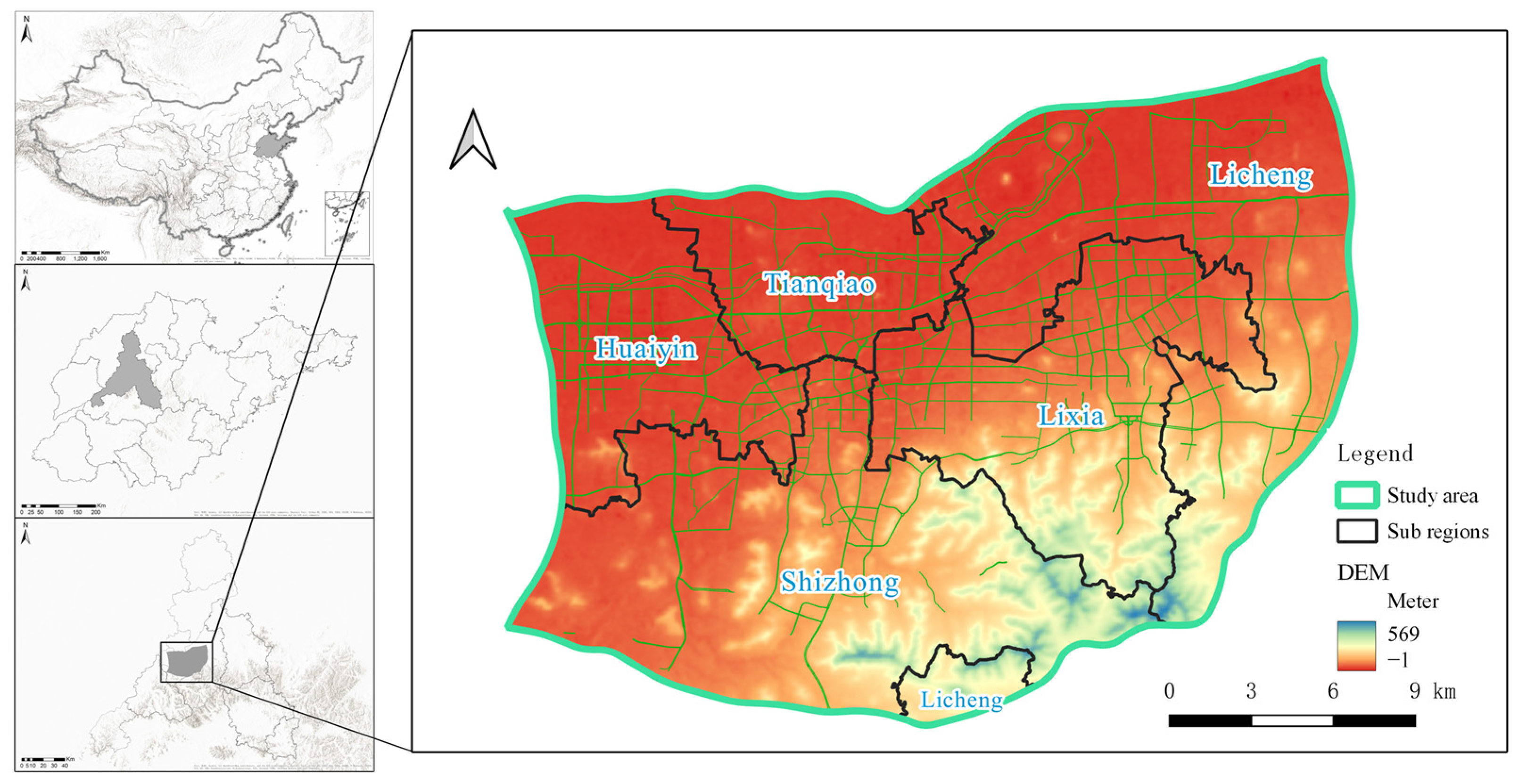
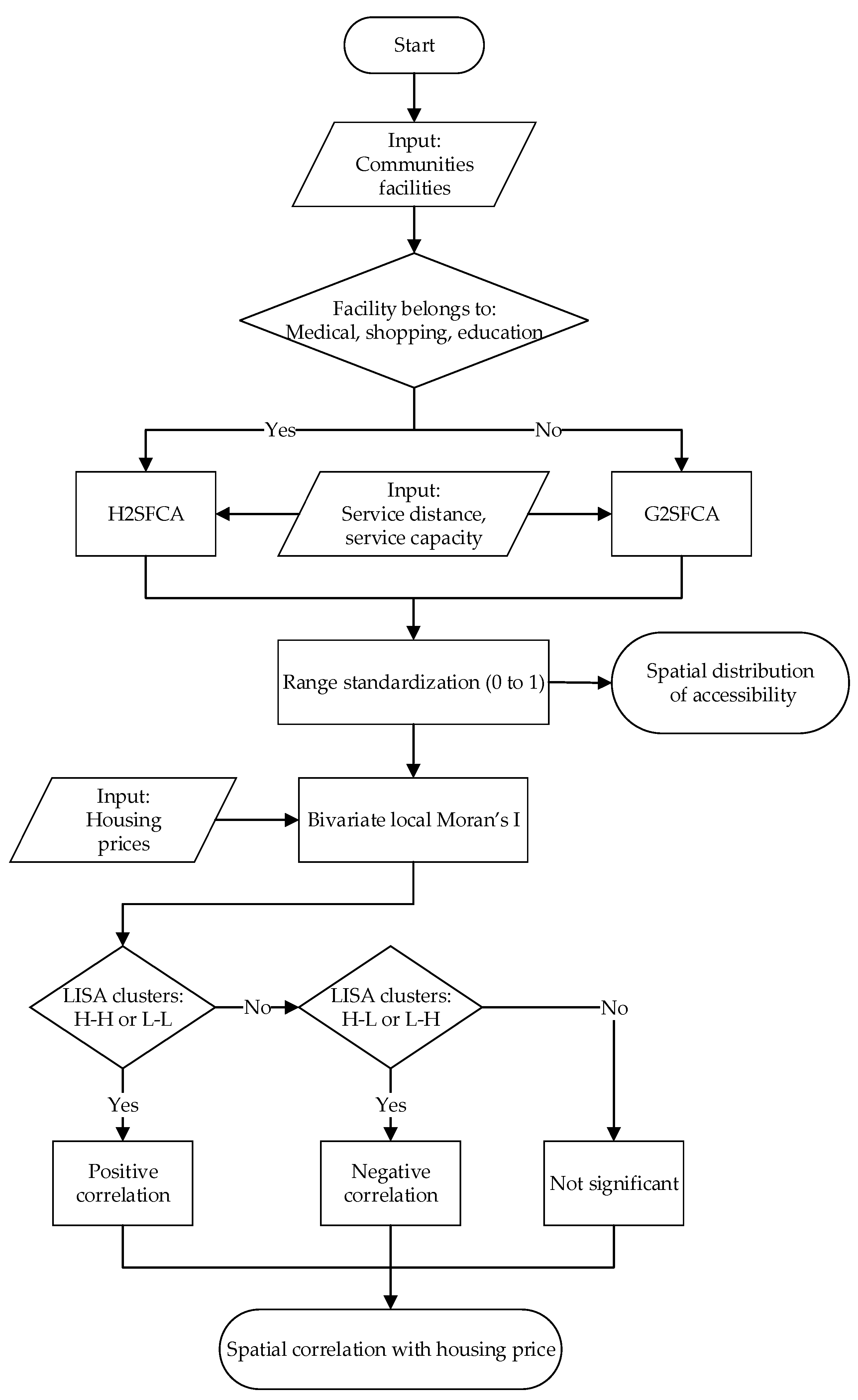
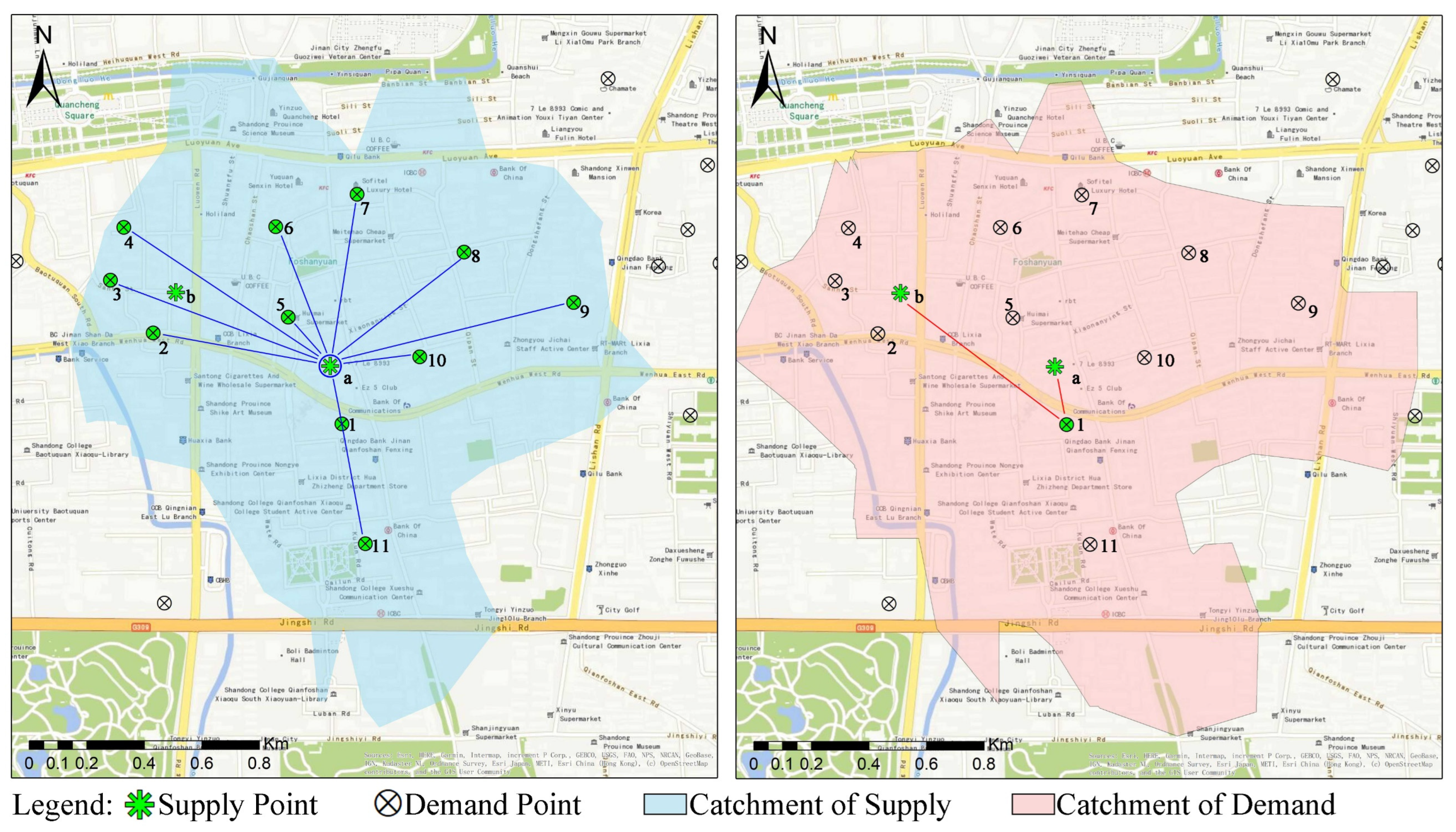
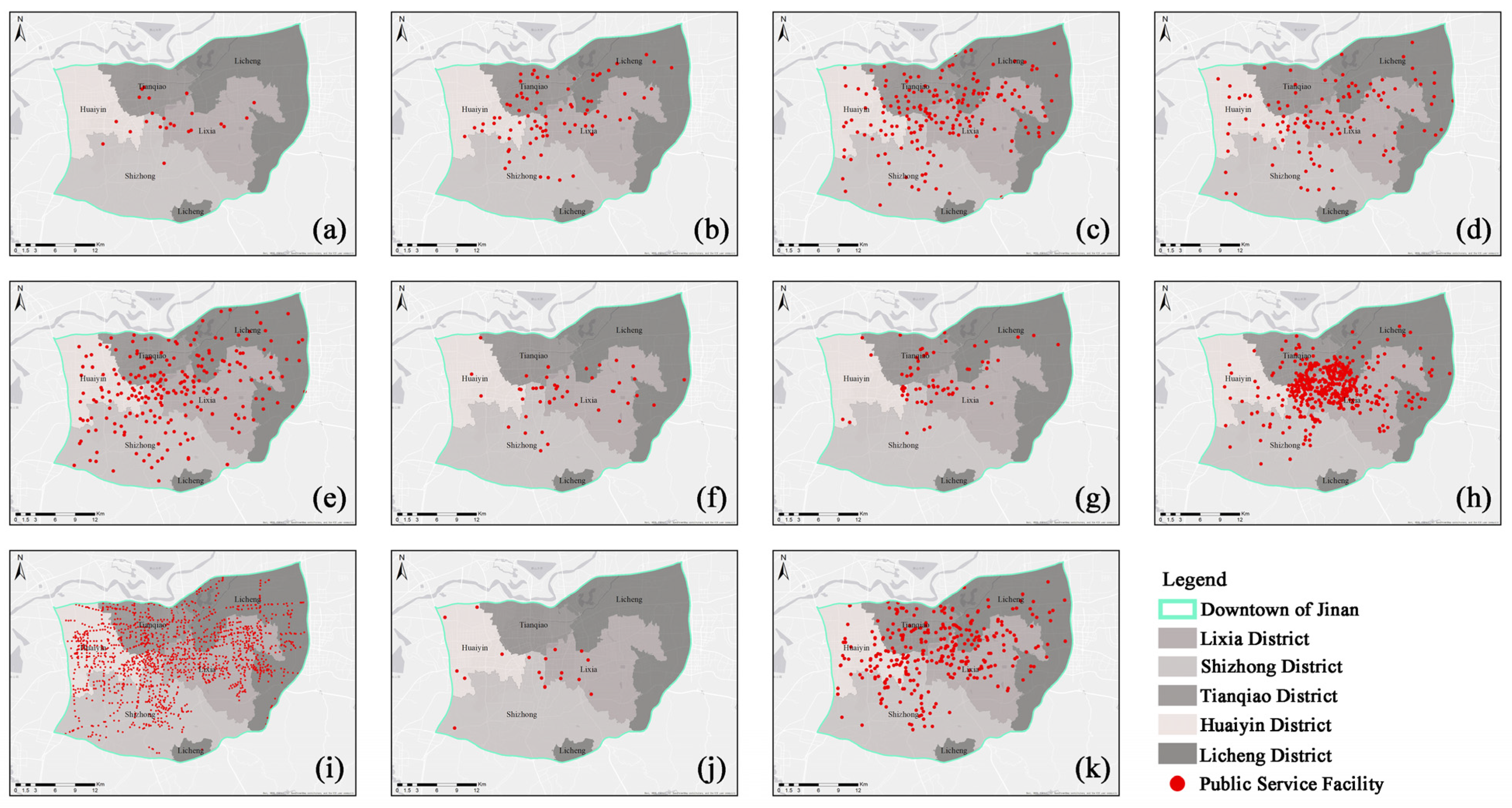
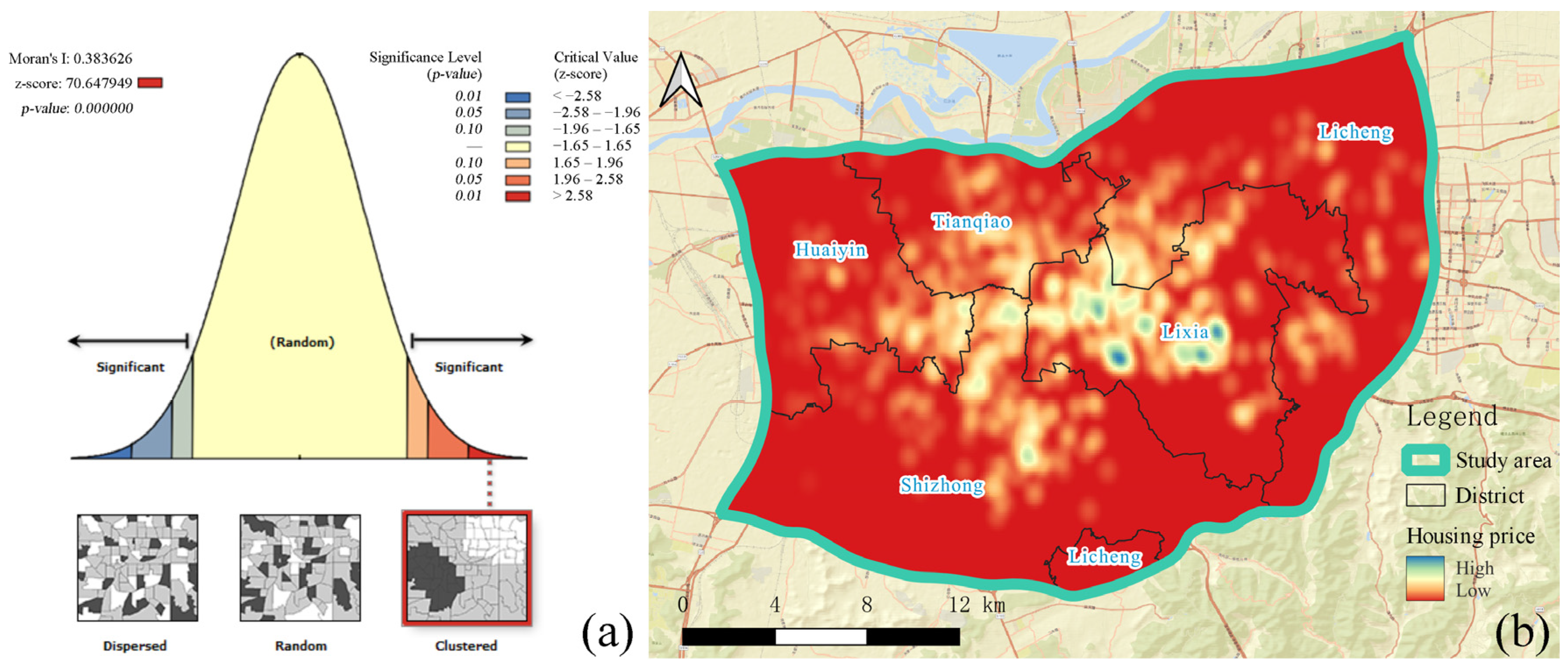
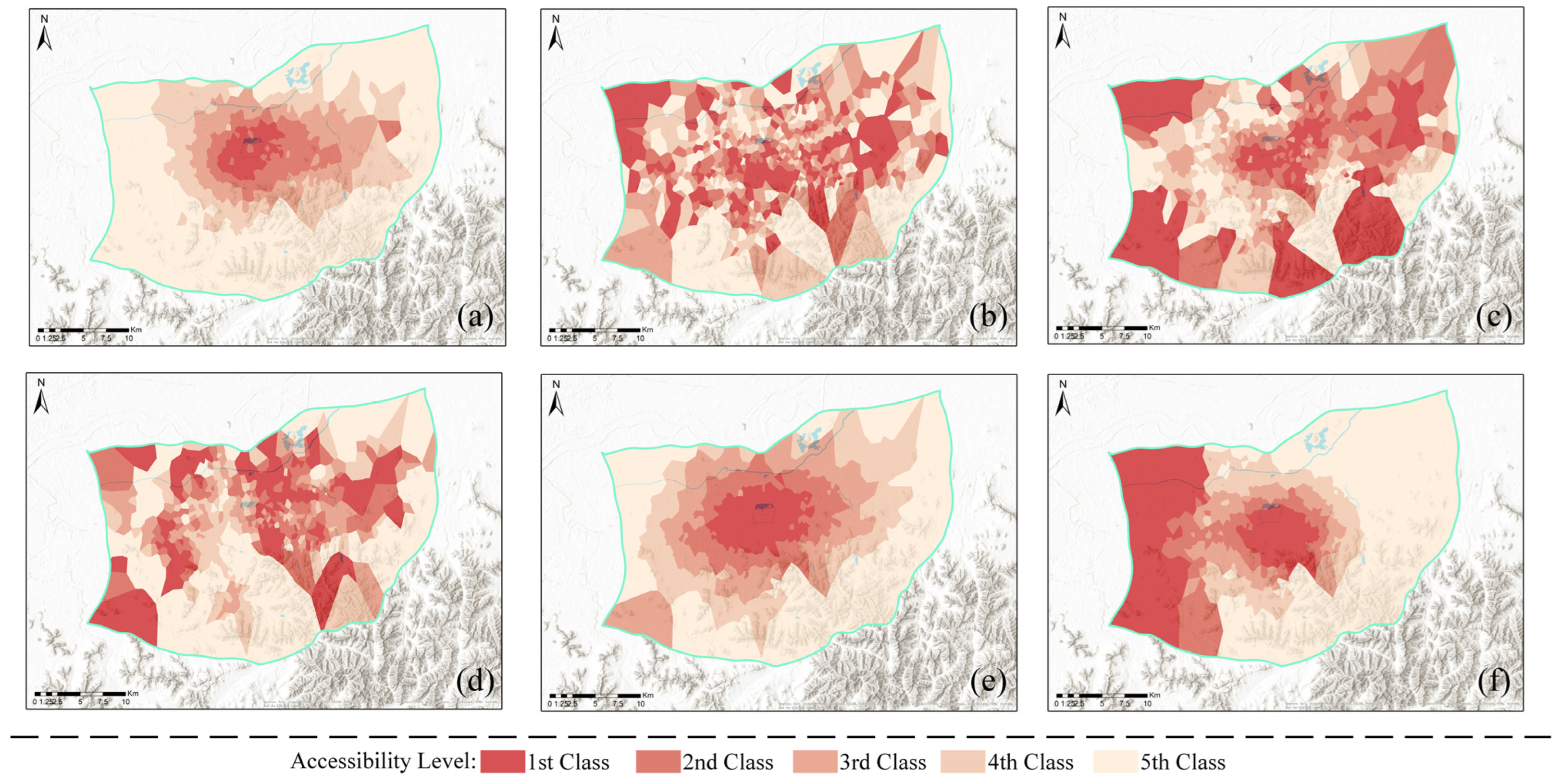

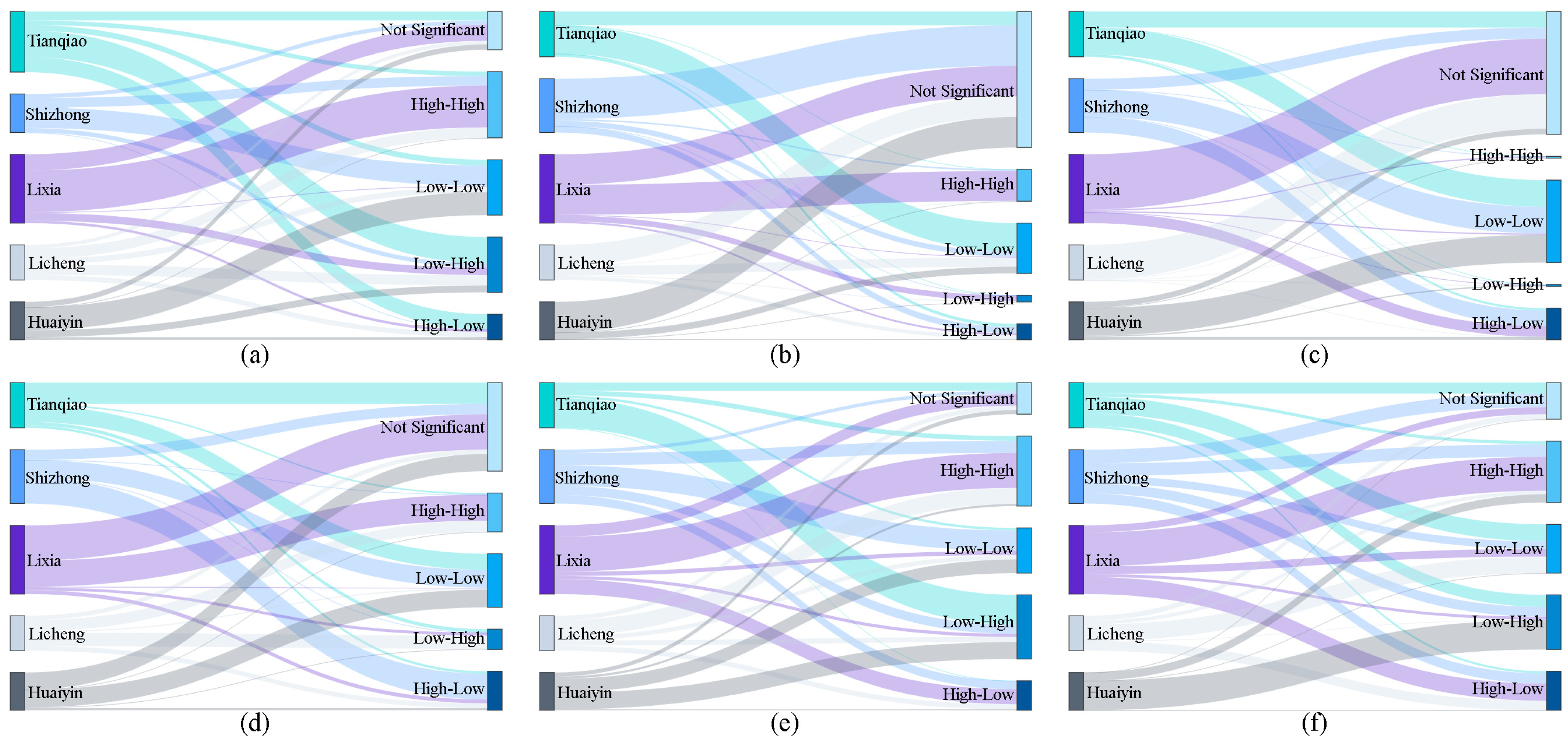

| Major Categories | Sub Categories | Quantity | Service Capacity | Time (min) | Service Distance (m) |
|---|---|---|---|---|---|
| Medical place | General hospital | 23 | 1002 | 30 | 15,000 |
| Secondary hospital | 82 | 151 | 16 | 8000 | |
| Tertiary hospital | 185 | 10 | 10 | 5000 | |
| Educational place | Middle school | 114 | 104 | 16 | 8000 |
| Primary school | 229 | 40 | 6 | 3000 | |
| Shopping place | Shopping mall | 45 | 10,000 | 20 | 10,000 |
| Shopping center | 65 | 6000 | 14 | 7000 | |
| Convenience store | 468 | 1000 | 4 | 2000 | |
| Bus stop | —— | 1557 | According to bus lines | 10 | 800 |
| Tourist attraction | —— | 18 | According to national levels | 30 | 15,000 |
| Grocery market | —— | 331 | 10,000 | 4 | 2000 |
| Cluster Type | Medical | Shopping | Education | Bus | Grocery | Tourist Attraction |
|---|---|---|---|---|---|---|
| Not significant | 13.10% | 15.87% | 51.06% | 56.48% | 36.77% | 15.21% |
| Positive correlation | 47.88% | 50.53% | 35.05% | 34.13% | 38.49% | 45.77% |
| Negative correlation | 39.02% | 33.60% | 13.89% | 9.39% | 24.74% | 39.02% |
Publisher’s Note: MDPI stays neutral with regard to jurisdictional claims in published maps and institutional affiliations. |
© 2022 by the authors. Licensee MDPI, Basel, Switzerland. This article is an open access article distributed under the terms and conditions of the Creative Commons Attribution (CC BY) license (https://creativecommons.org/licenses/by/4.0/).
Share and Cite
Yang, L.; Zhang, S.; Guan, M.; Cao, J.; Zhang, B. An Assessment of the Accessibility of Multiple Public Service Facilities and Its Correlation with Housing Prices Using an Improved 2SFCA Method—A Case Study of Jinan City, China. ISPRS Int. J. Geo-Inf. 2022, 11, 414. https://doi.org/10.3390/ijgi11070414
Yang L, Zhang S, Guan M, Cao J, Zhang B. An Assessment of the Accessibility of Multiple Public Service Facilities and Its Correlation with Housing Prices Using an Improved 2SFCA Method—A Case Study of Jinan City, China. ISPRS International Journal of Geo-Information. 2022; 11(7):414. https://doi.org/10.3390/ijgi11070414
Chicago/Turabian StyleYang, Luoan, Shumin Zhang, Mei Guan, Jianfei Cao, and Baolei Zhang. 2022. "An Assessment of the Accessibility of Multiple Public Service Facilities and Its Correlation with Housing Prices Using an Improved 2SFCA Method—A Case Study of Jinan City, China" ISPRS International Journal of Geo-Information 11, no. 7: 414. https://doi.org/10.3390/ijgi11070414







